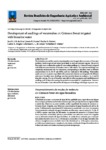Use este identificador para citar ou linkar para este item:
http://www.alice.cnptia.embrapa.br/alice/handle/doc/1023037Registro completo de metadados
| Campo DC | Valor | Idioma |
|---|---|---|
| dc.contributor.author | SILVA, J. E. S. B. da | pt_BR |
| dc.contributor.author | MATIAS, J. R. | pt_BR |
| dc.contributor.author | GUIRRA, K. S. | pt_BR |
| dc.contributor.author | ARAGÃO, C. A. | pt_BR |
| dc.contributor.author | ARAUJO, G. G. L. de | pt_BR |
| dc.contributor.author | DANTAS, B. F. | pt_BR |
| dc.date.accessioned | 2015-09-01T11:11:11Z | pt_BR |
| dc.date.available | 2015-09-01T11:11:11Z | pt_BR |
| dc.date.created | 2015-09-01 | pt_BR |
| dc.date.issued | 2015 | pt_BR |
| dc.identifier.citation | Revista Brasileira de Engenharia Agrícola e Ambiental, v. 19, n. 9, p. 835-840, 2015. | pt_BR |
| dc.identifier.issn | 1807-1929 | pt_BR |
| dc.identifier.uri | http://www.alice.cnptia.embrapa.br/alice/handle/doc/1023037 | pt_BR |
| dc.description | The limited access and the scarcity of good quality water for agriculture are some of the major problems faced in agricultural areas, particularly in arid and semiarid regions. The aim of this study was to evaluate the quality of watermelon seedlings (cv. Crimson Sweet), irrigated with different concentrations of biosaline water of fish culture. The experimental design was completely randomized with five treatments, corresponding to biosaline water at different concentrations (0, 33, 50, 67 and 100%), and four replicates of 108 seedlings. Watermelon seeds were sown in plastic trays filled with commercial substrate and irrigated with different solutions of biosaline water. Seedlings were harvested for biometric analysis at 14, 21 and 28 days after sowing. The use of biosaline water did not affect emergence and establishment of seedlings until 14 days after sowing, the period recommended for transplantation. However, the use of biosaline water affected the development of seedlings with longer exposure time. | pt_BR |
| dc.language.iso | eng | eng |
| dc.rights | openAccess | eng |
| dc.subject | Água biossalina | pt_BR |
| dc.subject | Água residuária | pt_BR |
| dc.subject | Watermelon | pt_BR |
| dc.title | Development of seedlings of watermelon cv. Crimson Sweet irrigated with biosaline water. | pt_BR |
| dc.type | Artigo de periódico | pt_BR |
| dc.date.updated | 2016-03-29T11:11:11Z | pt_BR |
| dc.subject.thesagro | Melancia | pt_BR |
| dc.subject.thesagro | Salinidade | pt_BR |
| dc.subject.thesagro | Germinação | pt_BR |
| dc.subject.thesagro | Irrigação | pt_BR |
| dc.subject.thesagro | Citrullus Lanatus | pt_BR |
| dc.subject.thesagro | Muda | pt_BR |
| dc.subject.nalthesaurus | Wastewater | pt_BR |
| dc.subject.nalthesaurus | Salinity | pt_BR |
| dc.subject.nalthesaurus | Germination | pt_BR |
| riaa.ainfo.id | 1023037 | pt_BR |
| riaa.ainfo.lastupdate | 2016-03-29 | pt_BR |
| dc.identifier.doi | 10.1590/1807-1929/agriambi.v19n9p835-840 | pt_BR |
| dc.contributor.institution | JOSÉ E. S. B. DA SILVA, UNIVERSIDADE DO ESTADO DA BAHIA | pt_BR |
| dc.contributor.institution | JANETE R. MATIAS, FUNDAÇÃO DE AMPARO À CIÊNCIA E TECNOLOGIA DE PERNAMBUCO | eng |
| dc.contributor.institution | KEYLAN S. GUIRRA, UNIVERSIDADE DO ESTADO DA BAHIA | eng |
| dc.contributor.institution | CARLOS A. ARAGÃO, UNIVERSIDADE DO ESTADO DA BAHIA | eng |
| dc.contributor.institution | GHERMAN GARCIA LEAL DE ARAUJO, CPATSA | eng |
| dc.contributor.institution | BARBARA FRANCA DANTAS, CPATSA. | eng |
| Aparece nas coleções: | Artigo em periódico indexado (CPATSA)  | |
Arquivos associados a este item:
| Arquivo | Descrição | Tamanho | Formato | |
|---|---|---|---|---|
| Barbara2015.pdf | 520.67 kB | Adobe PDF |  Visualizar/Abrir |









